Table of Contents
Introduction
Search engines have undergone a seismic shift, and at the center of this transformation is Google’s AI Overviews. Whether you’re an SEO professional, digital marketer, or a business owner relying on organic traffic, understanding this new feature is no longer optional—it’s essential.
AI Overviews represent a leap from traditional search snippets to intelligent, generative answers that reshape how content is displayed, consumed, and valued.
In this article, we’re diving deep into Google’s AI Overviews—how they work, what they mean for your rankings, and how you can adapt your strategy in a way that not only survives but thrives in this new era of search.
What Are Google AI Overviews?
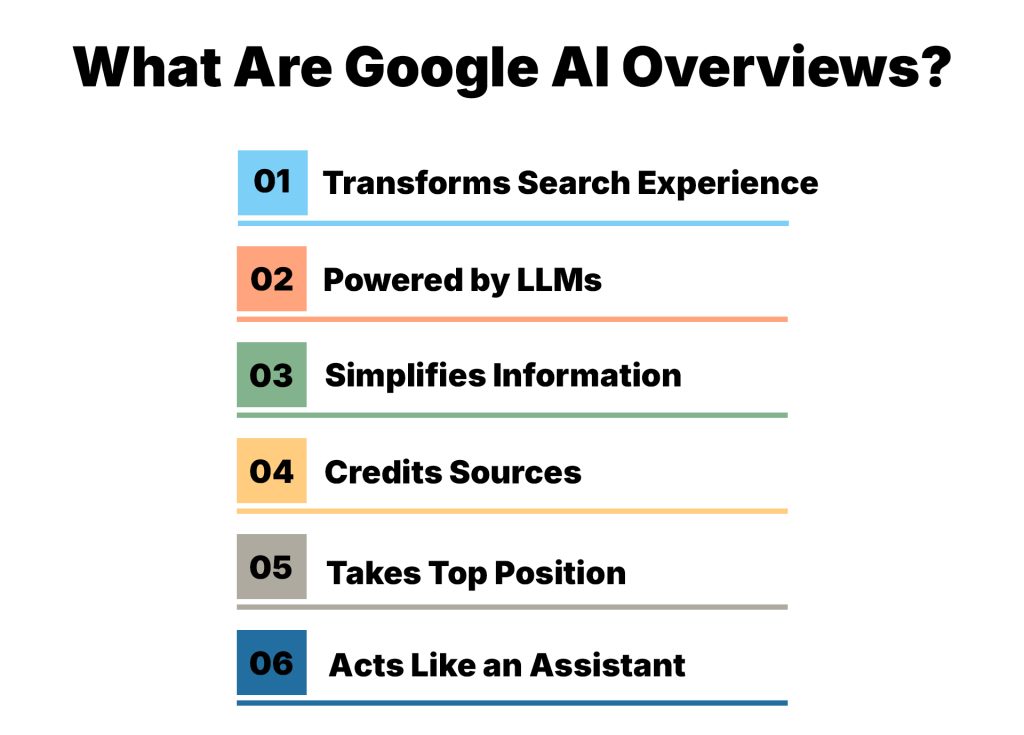
- Transforms search experience: Google AI Overviews revolutionize traditional search by providing AI-generated summaries instead of just blue links, offering instant, conversational answers directly on the results page.
- Powered by LLMs: These summaries are dynamically created using Google’s large language models, such as Gemini (formerly Bard) and PaLM, which interpret and synthesize data across the web in real time.
- Simplifies Information: By combining contextual breakdowns like steps, lists, and comparisons, AI Overviews make complex information easy to understand at a glance.
- Credits Sources: Each overview includes hyperlinks to the websites used for generating the summary, ensuring transparency and encouraging users to explore further.
- Takes Top Position: AI Overviews often appear above organic search results, sometimes even pushing the #1 ranking lower, reshaping how visibility and traffic are distributed.
- Acts Like an Assistant: Integrated directly into Google Search, this feature delivers accurate, concise, and conversational responses—helping users get answers faster than ever before.
How Do AI Overviews Work?
At the heart of AI Overviews is Google’s generative AI, which operates using complex LLMs that are trained to understand context, intent, and meaning across multiple languages and domains.
So how does Google decide when and how to generate an overview?
Let’s break it down step-by-step:
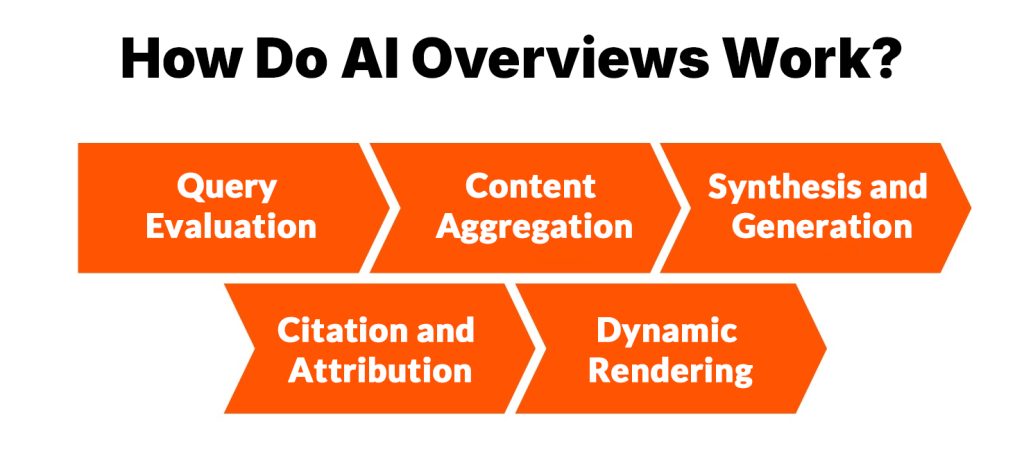
- Query Evaluation: When you enter a query, Google’s AI first determines if it’s suitable for an AI Overview. It typically kicks in for complex, multi-part, or informational queries — things like “how does climate change affect coral reefs?” or “what are the pros and cons of remote work?”
- Content Aggregation: The AI then pulls relevant data from high-authority sources across the web. These include blogs, news sites, videos, scientific publications, and sometimes structured databases like Wikipedia or medical libraries.
- Synthesis and Generation: Using the model’s internal understanding, it crafts a natural-language answer that condenses all that information into a digestible format. Think of it as an AI “mashup” of the top 10 search results.
- Citation and Attribution: Underneath the generated content, Google usually includes links to the sources it pulled from. These are clickable, giving users the option to read further or verify the details.
- Dynamic Rendering: These overviews are not pre-written—they’re generated live in response to a query. So if you change your wording slightly, the AI Overview may also change, reflecting the nuance in your question.
Importantly, Google doesn’t just regurgitate what’s on the web. It rephrases, condenses, and sometimes even restructures content to create something new. That’s why some experts are raising alarms about content ownership, accuracy, and plagiarism — more on that later.
Impact on SEO and Organic Traffic
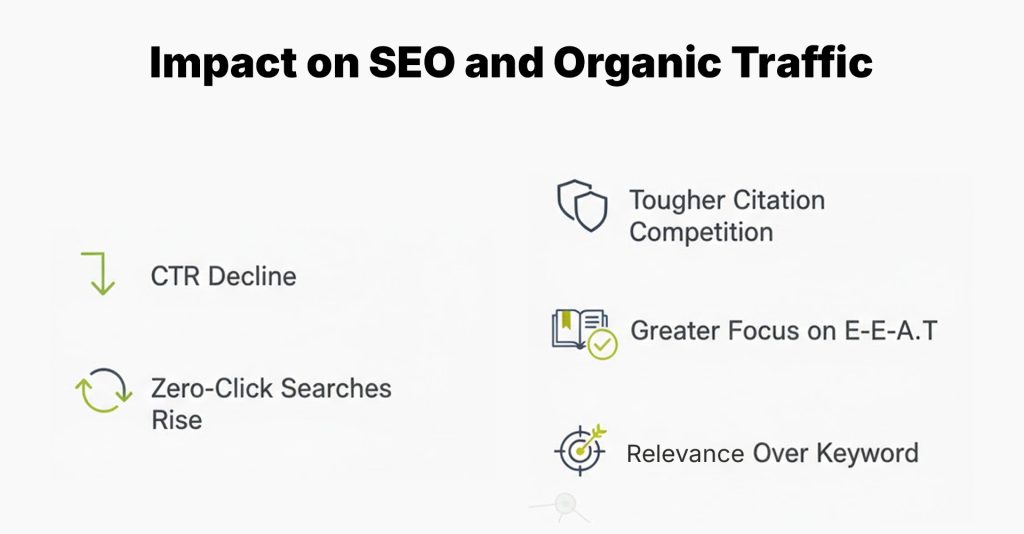
- CTR Decline: Many SEOs are already reporting that rankings that used to bring in thousands of clicks per month are now delivering much less traffic. Even if you’re ranking #1, if an AI Overview appears above you, users may never scroll down.
- Zero-Click Searches Rise: AI Overviews are the latest form of “zero-click” content — where Google answers the question without requiring the user to click any link. This trend has been growing for years, with features like Featured Snippets, Knowledge Panels, and People Also Ask boxes.
- Tougher Citation Competition: Ironically, getting mentioned as a source in an AI Overview is now the new SEO goldmine. If Google uses your page as part of the answer and includes a link, you can still receive high-quality traffic — but only if your content is strong, relevant, and trustworthy.
- Greater Focus on E-E-A-T: Google’s algorithm heavily relies on E-E-A-T (Experience, Expertise, Authoritativeness, Trustworthiness) to decide which content it uses in AI Overviews. That means your site’s authority and content quality are more important than ever.
- Relevance Over Keyword: Traditional SEO tactics that rely on keywords alone won’t cut it anymore. Google’s AI looks at the meaning and context of your content. If it doesn’t directly helpfully answer the user’s question, it might get ignored.
In summary, AI Overviews are disrupting the very foundation of how we think about SEO. But rather than fear the change, smart SEOs are looking at how to adapt and get ahead of it — which leads us to the next section.
How to Optimize for AI Overviews
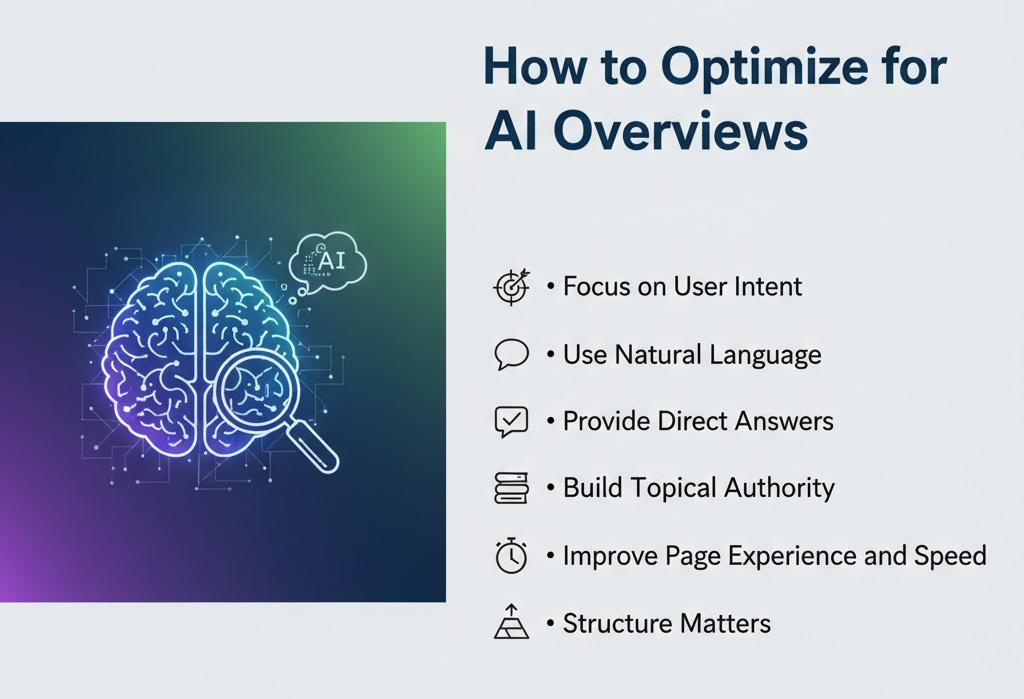
While Google hasn’t revealed the exact formula, there are clear patterns and best practices emerging. The good news? It’s not rocket science. The bad news? It takes more than just tweaking some meta tags.
Here’s a roadmap to start optimizing:
- Focus on User Intent: Understand what the user really wants to know, not just the keywords they’re using. Write content that answers questions clearly and thoroughly, especially long-tail queries.
- Use Natural Language: AI prefers conversational, well-structured content. Avoid jargon or overly technical phrasing unless your audience demands it. Think “explain it like I’m five” — unless you’re writing for experts.
- Provide Direct Answers: If someone asks, “How does X work?”, your article should include a straightforward explanation early in the post. Use bullet points, numbered steps, or short paragraphs to increase clarity.
- Build Topical Authority: Google prefers to cite experts and niche authorities. If your website is all over the place, focus on building deep content within one area. Cover related subtopics and cross-link pages.
- Improve Page Experience and Speed: You won’t get featured if your site is slow, broken, or hard to read. AI Overviews pull from clean, structured, mobile-friendly pages.
- Structure Matters: Use H2s, H3s, and H4s. Break down your content logically. Add FAQs, tables, and schema markup where possible. This makes it easier for Google’s crawlers — and AI — to digest your content.
Features of Google’s AI Overviews
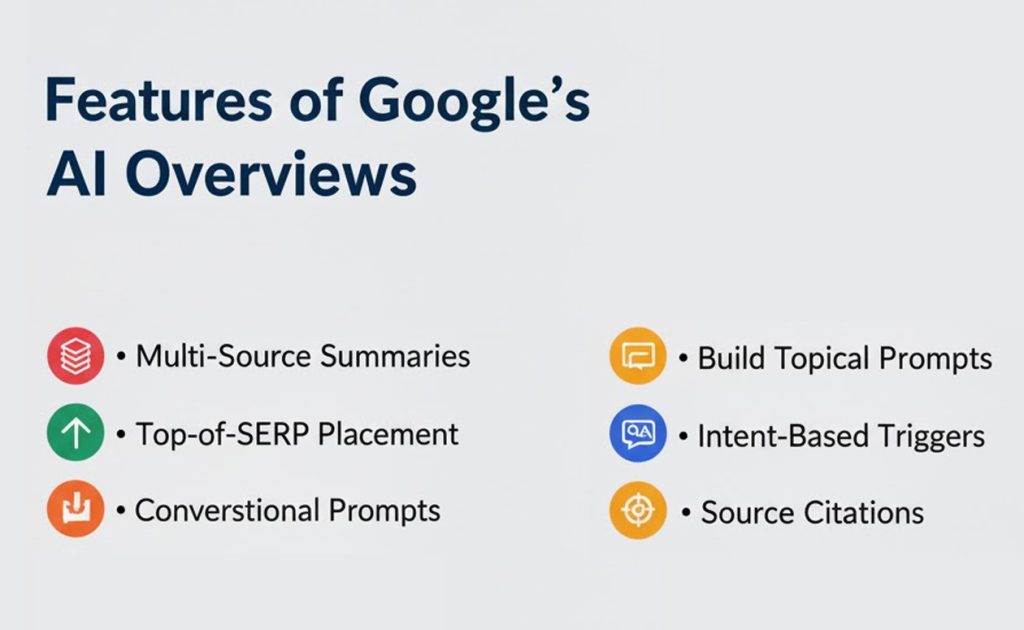
- Multi-Source Summaries: AI Overviews pull from multiple authoritative sites to create a well-rounded summary. This helps eliminate bias and presents users with a balanced view of the topic.
- Top-of-SERP Placement: The Overview typically appears above paid ads and organic listings — claiming prime visibility and changing traditional SEO click flow.
- Conversational Prompts: Users can interact by asking follow-up questions directly within the Overview, extending search sessions within Google instead of visiting external pages.
- Intent-Based Triggers: Most Overviews appear for informational or question-based searches such as “how,” “what,” or “why” queries.
- Source Citations: Each Overview provides cited sources, helping users validate accuracy while still encouraging trust in the AI response.
What’s Next for AI in Search?
The future of search is becoming increasingly AI-driven and conversational.
Google is already experimenting with “AI Mode”, a chat-like interface where users can refine searches naturally.
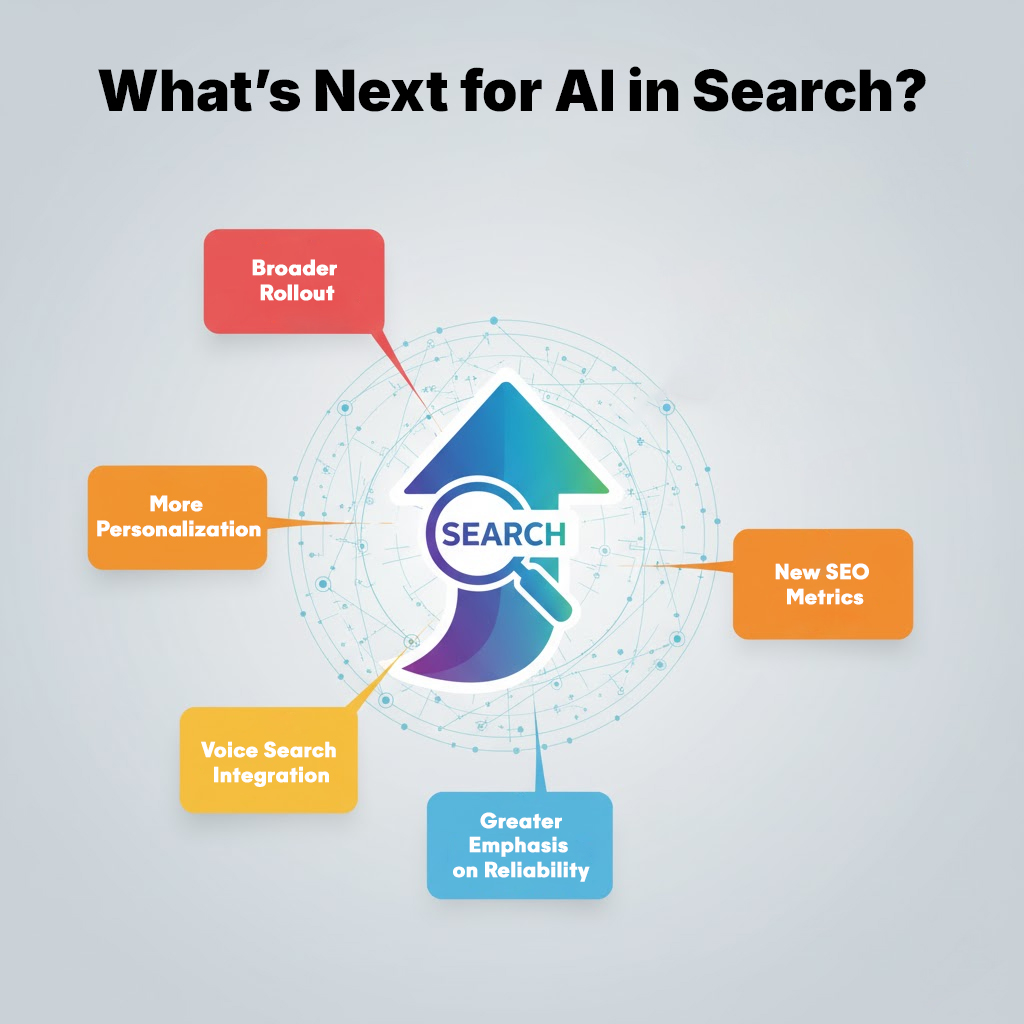
Here’s what to expect next:
- Broader Rollout: AI Overviews will likely expand to more categories, including local and shopping searches.
- More Personalization: AI may tailor summaries based on user preferences, location, or browsing history.
- Voice Search Integration: Expect voice-activated summaries through Google Assistant and Android search.
- Greater Emphasis on Reliability: After some early errors, Google is tightening quality standards — rewarding accurate, sourced content.
- New SEO Metrics: Future analytics tools may include “AI Overview Citation Rate” or “Overview Visibility Score.”
Conclusion
Google’s AI Overviews mark the beginning of a new era in search — one where AI acts as both researcher and presenter.
For businesses and content creators, success now depends on being recognized by AI as a credible, valuable source of information.
While traffic patterns may shift, the opportunity for visibility, brand authority, and long-term trust remains stronger than ever. By focusing on clarity, expertise, and ongoing optimization, you can ensure your content thrives in this next generation of SEO.
Deepak Wadhwani has over 20 years experience in software/wireless technologies. He has worked with Fortune 500 companies including Intuit, ESRI, Qualcomm, Sprint, Verizon, Vodafone, Nortel, Microsoft and Oracle in over 60 countries. Deepak has worked on Internet marketing projects in San Diego, Los Angeles, Orange Country, Denver, Nashville, Kansas City, New York, San Francisco and Huntsville. Deepak has been a founder of technology Startups for one of the first Cityguides, yellow pages online and web based enterprise solutions. He is an internet marketing and technology expert & co-founder for a San Diego Internet marketing company.



